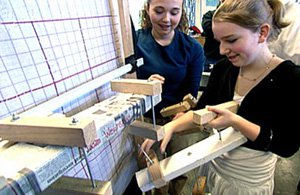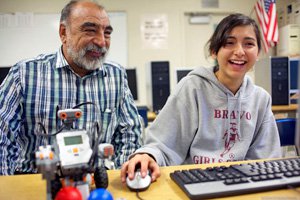Integrated Studies: A Short History
Venerable educators from John Dewey to Howard Gardner have extolled the virtues of studying subjects in a holistic, contextual way rather than in a vacuum.

In a ninth-grade math class, students analyze a variety of graphs to look for trends in Americans’ eating habits and public health patterns. In social studies, the same students do field investigations to compare the fresh produce selections at local grocers catering to different demographics. In English, they design advocacy campaigns to promote better nutrition in their low-income community, where diabetes affects many families.
There’s nothing coincidental about these connections between core academic subjects and the students’ own lives. In this example, teachers have teamed up to design an integrated study of where food comes from. In the course of answering that complex question, students are challenged to synthesize and apply concepts from math, geography, social science, health, economics, and English. They make important connections that cross disciplines and relate to their own experiences.
Integrated studies involves bringing together typically disconnected subjects so that students can arrive at more meaningful and authentic understanding. For more than a decade, researchers at Project Zero, at the Harvard Graduate School of Education, have been studying interdisciplinary work across a wide range of settings -- from research centers tackling some of society’s thorniest challenges to school classrooms preparing students for a complex future. They have found interdisciplinary understanding to be a hallmark of contemporary knowledge production and also a primary challenge for today’s educators.
Helping students acquire interdisciplinary understanding doesn’t mean mixing in a smidgen of art or music to liven up a math or science lesson. Veronica Boix Mansilla -- who, with Howard Gardner, cofounded the Interdisciplinary Studies Project at Project Zero -- emphasizes the purpose behind integrated studies. Students build and demonstrate interdisciplinary understanding, she explains in a recent publication, "when they can bring together concepts, methods, or languages from two or more disciplines or established areas of expertise in order to explain a phenomenon, solve a problem, create a product, or raise a new question in ways that would have been unlikely through single disciplinary means."
From the economics of environmental disasters to the ethics of cloning, crosscutting issues are all around us. Applying an integrated-studies approach to learning not only prepares students for tackling these real-world challenges but also yields immediate benefits ranging from greater student engagement to deeper understanding of core content.
An Integrated-Studies Time Line
For the better part of a century, educational theorists have been advocating for a more integrated and less "siloed" approach to learning. As American philosopher John Dewey pointed out during the Progressive Era, "We do not have a series of stratified earths, one of which is mathematical, another physical, another historical, and so on. All studies grow out of relations in the one great common world."
Ralph Tyler, a major figure in 20th-century American education, described integration of subject areas as "the horizontal relationship of curriculum experiences," and he considered such connections to be essential for student learning. His thinking was informed by his work on the landmark Eight-Year Study, which followed students from 30 secondary schools during the 1930s. Researchers found that students were well-served by high schools that organized content not by isolated subjects but around overarching themes that connected disciplines.
Benjamin Bloom, a colleague of Tyler’s who went on to develop his famous Taxonomy of Educational Objectives, encouraged weaving "integrative threads" into the curriculum to foster connections across subject areas.
Educators such as Susan Kovalik have continued to build on this theoretical foundation. Kovalik has incorporated brain research -- and her teaching experience -- to create the Highly Effective Teaching model (formerly know as the Integrated Science of Learning model) and a curriculum design that emphasizes "big ideas" and thematic instruction.

Heidi Hayes Jacobs, whose most recent book is Curriculum 21: Essential Education for a Changing World, has been making the case for interdisciplinary-curriculum design for more than two decades. Conversely, in a discipline-based, context-design curriculum, in which students are forced by the bell schedule to shift their focus from subject to subject and often move from one space to another, the day is fragmented. "The primary disadvantage to this form of content construction is that it does not reflect the reality of life outside school. We simply do not function in a world where problems are discipline specific in regimented time blocks," noted Jacobs in the 1989 publication Interdisciplinary Curriculum: Design and Implementation.
A comprehensive review of research on integrated studies is offered in "The Logic of Interdisciplinary Studies," a 1997 paper by Sandra Mathison and Melissa Freeman. The authors found a number of benefits for learners, including acquisition of life skills such as cooperation and problem solving, greater motivation and academic achievement, better attitudes toward learning, and opportunities for more meaningful relationships between students and teachers. What’s more, they found that integrated studies provides a sensible way to learn about a world of rapidly expanding and changing information.
Yet in most American schools -- especially high schools -- educators continue to teach subjects in isolation based on schedules that divide learning into 50-minute chunks. School-reform efforts have done little to change this situation. The critical 1983 report "A Nation at Risk" set off a standards movement that largely reinforced a separation of disciplines. More recently, No Child Left Behind has ushered in an era of high-stakes testing that emphasizes math and reading, often at the expense of other subjects and interdisciplinary curriculums.
Moving Toward Integration
But change may be afoot. Susan M. Drake and Rebecca C. Burns, authors of Meeting Standards Through Integrated Curriculum, have found interest in integrated studies on the rise both in the United States and internationally as the standards movement matures. "Standards are not simply individual tasks that students must perform separately in each discipline," they argue. "Teachers can chunk the standards together into meaningful clusters both within and across disciplines. Once teachers understand how standards are connected, their perception of interdisciplinary curriculum shifts dramatically." Indeed, they emphasize that "some teachers see it as the only way to teach and to cover the standards."
Heidi Hayes Jacobs also sees a shift in favor of integrated studies. "It’s not a question of the disciplines versus interdisciplinary studies," she explains. "We do need in-depth, discipline-based work. But it needs to be modernized so that students can apply the range of those skills in viable and real interdisciplinary problems. I don’t see a debate anymore. It’s more strategically, how do we modernize -- upgrade -- the curriculum so that students will learn how to connect the various fields they have studied and apply them in absolutely interdisciplinary, integrated problem solving."

Leveraging the opportunities that integrated studies offers does not mean abandoning the disciplines. Each discipline asks different questions and offers its own methods for expanding knowledge. A scientist follows the approach of hypothesis, testing, and analysis to find out what’s true, while a historian assesses source material to arrive at a defensible interpretation of past events. An artist and a mathematician will solve problems in still different ways. Yet a foundation of subject-area expertise remains essential when we ask students to make connections across disciplines and apply understanding in new ways.
For example, in a middle school project that Boix Mansilla writes about, students learned about sound waves in physics and about the parts of musical instruments so they could explain how an instrument makes sound. It was all part of a course in which the students created an orchestra of traditional instruments and composed and performed a rhythmic piece. Teachers who designed the unit thoughtfully selected and organized learning goals from each of their disciplines. The outcomes "could not be accomplished through the lens of music or physics alone," Boix Mansilla concluded.
To help teachers bring integrated studies into their practice in a meaningful way, Project Zero researchers have outlined five fundamental aspects of quality interdisciplinary instruction: It frames topics that are worth teaching in an interdisciplinary way, identifies disciplinary tools that will enable students to understand such topics, integrates disciplines productively, contains a sequence of learning experiences, and assesses students’ interdisciplinary work. This framework was built on both a multiyear empirical study of interdisciplinary research and classroom practice, according to Boix Mansilla.
Similarly, Drake and Burns suggest that teachers "include only those concepts and skills that fit together naturally and validly in an integrated unit. They should never force integration or choose activities that are superficial and do not address important concepts and skills within disciplines."
Finding Time to Connect
One of the challenges of implementing this approach is finding the time for teachers from different disciplines to work together. Schools that emphasize teacher collaboration and teaming are well-positioned for integrated studies. Similarly, in schools that support project-based learning, teachers are often able to design real-world projects that are not limited to one subject area.
Effective school models such as Expeditionary Learning, Envision Schools, and High Tech High regularly incorporate integrated projects. The academically rigorous International Baccalaureate program also emphasizes interdisciplinary study, particularly at the middle school level.
For students, such efforts can yield what James Beane, author of Curriculum Integration: Designing the Core of Democratic Education, has called a more coherent curriculum "that holds together, that makes sense as a whole -- and its parts, whatever they are, are unified and connected by that sense of whole."